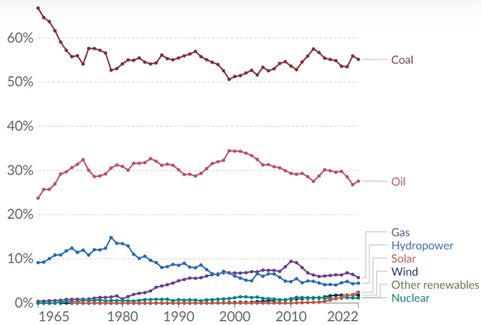Introduction
Currently, the majority of the energy used for electricity, transportation, industries, agriculture, buildings are derived from degradation of buried fossils over millions of years. Their main advantages are very high specific energy (MJ/kg), energy density (MJ/L), low cost and the availability of existing infrastructure to utilize these fuels. The low heating values (LHV) of common fuel materials are given in Table 1. It can be seen that fossil fuels have high energy density as compared to alternatives like hydrogen, Li-ion batteries, etc. Fuels like Uranium, Plutonium-238 that are used for nuclear reactions do have very high gravimetric and volumetric energy density. However, the nuclear industry is highly regulated and not open to private entities.
| Material | Specific energy (MJ/kg) | Energy Density (MJ/L) |
| Coal | 26 – 33 | 34 – 43 |
| Natural Gas | 53.6 | 0.0364 |
| Compressed natural gas (CNG) | 53.6 | 9 |
| LPG Butane | 49.1 | 27.7 |
| Petrol | 46.4 | 34.2 |
| Diesel | 45.6 | 38.6 |
| Jet Fuel | 43 | 35 |
| Crude Oil | 41.9 | 37 |
| Hydrogen | 119.9 | 0.01 |
| Lithium Ion batteries | 0.36 – 0.875 | 0.9 – 2.63 |
| Uranium | 80,620,000 | 1,539,842,000 |
| Plutonium – 238 | 2,239,000 | 43,277,631 |
Currently, overall global energy consumption is approximately 176,000 TWh in 2021 with annual growth of 1-2% [2].
Demand
India’s annual energy generation was 10,123 TWh in 2022 [3]. Individual contributions to the energy mix are shown in Figure 1. Coal amounts to 55%, oil is about 28%, gas is about 6%, hydropower is 4.5%, and all renewables combined contribute 5.5% to the overall energy mix [4]. The total electricity generation in India was 1844 TWh in 2022 [5].

Coal
India’s annual coal production was 893.19 million tons (MMT) in 2022-23 [6]. Total imports in the same year were 237.67 MMT, amounting to 21% of the total annual coal usage, costing $48 billion [7].
Crude Oil
India’s crude oil production in 2022-23 was 29.2 million metric tons (MMT) [8]. The total consumption of petroleum products in the same year was 223 million metric tons (MMT). The products include LPG, naphtha, bitumen, petroleum coke, petrol (MS), diesel, etc. LPG (13%), petrol (16%), and diesel (38%) contribute to close to 67% of the total petroleum products consumption. Crude oil import was 232.7 MMT in 2022-23, while petroleum products import was 44.6 MMT, with total imports of 277 MMT. Finished petroleum products are also exported from Indian refineries which totaled 61 MMT in 2022-23, so the net import was 216 MMT in 2022-23. The net petroleum products imports costs Indian government $127 billion which amounts to 18% of India’s merchandise imports of $714 billion [9]. Average pricing in 2022-23 was $93.15 per barrel (159 liters).
Natural Gas
India has a proven natural gas reserves of 1218 billion SCM (standard cubic meters) as of 2017 [10]. Based on current consumption, it is expected to last for the next 20 years. India’s annual natural gas production in 2022-23 was 33.66 billion SCM, more than two-thirds of which is produced off-shore [11]. Total natural gas consumption in 2022-23 was close to 60 billion SCM. Total imports (as LNG) in the same year were 26.3 billion SCM, amounting to 44% of the total natural gas consumption, costing close to $13 billion.
Policy Strategies
Coal
India plans to reduce coal-based thermal power generation capacity from 52% at present to 32% by 2030 [12]. However, India needs to add 32 GW of thermal power capacity by 2032 to meet increasing energy demand [13]. Reduction in the use of coal is expected once grid energy storage and carbon removal technologies mature. Local coal production is expected to increase in the current fiscal year. Non-essential coal import shall be suspended. However, high-grade coal like anthracite, and coking coal need to be imported since they are not available in the country [14].
Crude Oil
India is looking to increase domestic production of crude oil and natural gas to reduce crude oil import dependence. It is promoting ethanol blending program and pushing for adoption of electric vehicles (EV). Currently, ethanol blending has reached 12% in October 2023 [15]. The target has been raised to achieve 20% ethanol blending in 2025-26 [16]. The substitute of biodiesel to diesel with a target blending of 5% by 2030 has been proposed. Another focus area is to carry out improvement in the efficiencies of equipment used in industries and refineries.
Natural Gas
One of the major ways for reducing crude oil import dependence is substitution of petrol/diesel/LPG with natural gas. Not only does this help with reducing imported crude oil dependence, but also helps with lowering CO2 emissions since natural gas is the least polluting of all of the fossil fuels. Presently, share of natural gas in India’s energy mix is 6.7% [17]. However, the government has set a target of 15% by 2030. The government has come up with Compressed biogas blending obligation (CBO) to reduce dependence on natural gas imports. Mandatory CBO from 2025-26 starts at 1%, leading to 5% by 2028-29 [18]. It is also trying to promote alternatives to mined natural gas. Prominent among them are coal bed methane (CBM) gas development and compressed biogas (CBG) production under SATAT scheme. CBM production for 2023-24 was 0.48 billion SCM till November end.
